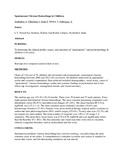| dc.description.abstract | PURPOSE:
To determine the clinical profile, causes, and outcomes of "spontaneous" vitreous hemorrhage in children (<18 years).
DESIGN:
Retrospective computer-assisted chart review.
METHODS:
Charts of 124 eyes of 76 children who presented with nontraumatic, nonsurgical vitreous hemorrhage between 2002 and 2012 were reviewed. All children underwent an appropriate ocular and systemic examination. Data collected included demographics, visual acuity, cause of "spontaneous" vitreous hemorrhage, ocular and systemic findings at presentation and at last follow-up, investigations, management details, and visual outcomes.
RESULTS:
The median age was 153.45 ± 56.19 months. There were 39 female and 37 male patients. Forty-eight patients had bilateral vitreous hemorrhage. The most common presenting complaints were diminished vision (96.45%) and behavioral changes (87.24%). The mean baseline BCVA in logMAR was 2.25 ± 1.11. The most common causes included vasculitis (34.6%) and hematologic disorders (27.4%). Patients were given medical therapy (topical and/or systemic) or underwent laser photocoagulation (29%) and/or surgery (55.6%). Twenty-nine eyes (23.3%) did not require any intervention. The mean number of surgeries was 1.89 ± 1.45 (range 1-4 surgeries). The mean final visual acuity was 0.76 ± 0.58 logMAR and was significantly better than the baseline (P < .001). The best anatomic and visual outcomes were seen in vasculitis, whereas congenital disorders such as retinoschisis had the worst.
CONCLUSIONS:
Spontaneous pediatric vitreous hemorrhage has a diverse etiology, vasculitis being the most common cause in our series. A comprehensive evaluation (systemic and ocular) is required to ensure that vision- and life-threatening conditions are not missed. | en |

